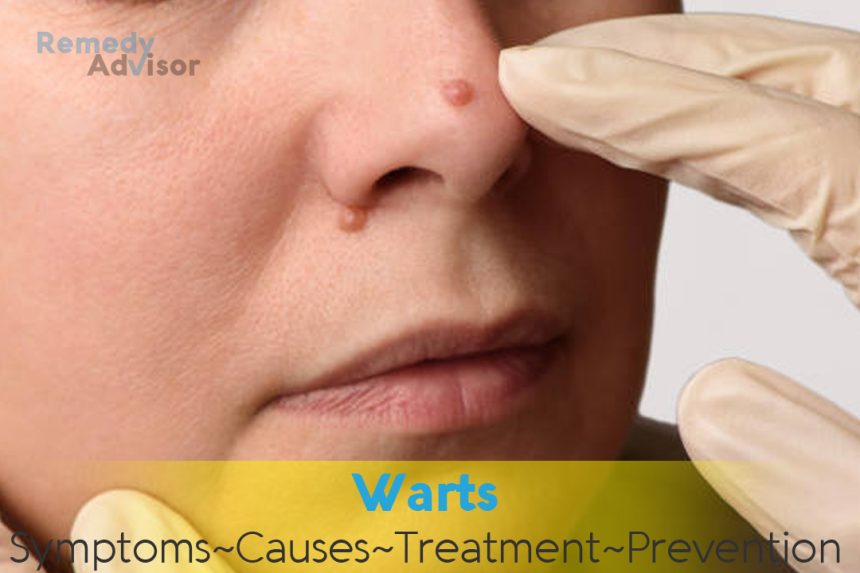What is it
Warts are benign tumors in the external skin layer produced by the human papilloma virus. They may occur anyplace on the body, but they look diverse with respect to where they grow. Warts typically appear on fingers and tops of hands, where they protrude as dry growths with a horny surface. On pressure areas such as the palms and soles, they grow inward. One of the most painful types is the plantar wart, a light colored, flat growth on the sole of the foot that extends below the surface of the skin.
Ordinary warts are slightly contagious; they spread most commonly from one location to another for example, from finger to finger on an infected person, rather than from person to person. The exceptions are anal and genital warts, which are highly contagious and may contribute to the development of penile and cervical cancers. Warts on the larynx can also be dangerous. These three types always require medical attention.
Warts, which afflict 7 to 10 percent of the population, never spread from one species to another: that old story about toads causing warts in people is just a myth. (The bumps on toads and frogs, though wart like in appearance, are unrelated to actual warts, which are found only on humans.) Warts are most common among children and young adults, as well as people with weakened immune systems, such as those infected with HIV (human immunodeficiency virus). Of the several million people who seek treatment for warts each year, about 70 percent are under 40 years of age.
Symptoms
- A benign, small growth on the skin, typically on the hands.
- May be pale or dark, rough or smooth, raised or flat. Warts seldom bleed or itch.
- Usually painless, although plantar warts, located on the soles of the feet, can be quite painful.
What causes it
Warts are caused by strains of human papilloma virus that can enter the skin through tiny breaks, cuts, or scratches and can be transmitted by direct physical contact with another person. Plantar warts may be spread through swimming pools or showers.
What if you do nothing
Non-genital warts are harmless, and the best treatment for them may be no treatment at all. Up to 80 percent of non-genital warts disappear by themselves in one or two years (typically in two years, at least in children). Genital and anal warts, on the other hand, must be treated. And because plantar warts can make walking uncomfortable, they, too, may need medical attention.
Unfortunately, warts that have gone away (a process known as spontaneous remission) can also return just as mysteriously.
Home remedies
If you think you have a wart, it’s a good idea to see a doctor for evaluation, since it might be another condition, such as a skin cancer. If it is a wart, deciding whether to treat it comes down to whether it interferes with your walking or running, or whether it is causing social problems. If not, then it may be best to leave the wart alone. (Never cut a wart yourself, as there is a risk of bleeding, infection, and scarring.)
The fact that most warts disappear on their own has bred all kinds of legends and given credence to hundreds of home remedies. Huckleberry Finn recommended handling dead cats as a treatment for warts, and Tom Sawyer believed that spunk-water (stagnant water in an old tree stump) could cure warts, at least if you approached the stump backward at midnight and recited the proper spell. Here are some remedies that have proved to be somewhat more effective.
Tape it
This is an inexpensive, noninvasive, and popular remedy. Wrap the area in several layers of waterproof tape and leave it on for one week. Repeat the treatment. Sometimes the wart goes away.
Wart removal preparations
Drugstores sell salicylic acid products for the removal of warts, and if you decide to try one of these be sure to protect the surrounding skin, since it can get burned. Do not use these remedies on facial, genital or anal warts.
Paint on the low-strength salicylic acid recommended by your physician or pharmacist. The medication may take weeks to obtain favorable results.
Prevention
Don’t cut or scratch
Wans can easily spread if cut or scratched.
Wear shower shoes
Plantar warts may be spread through moist environments like swimming pools or showers. Sandals or shower shoes at poolside or in locker rooms can keep you from spreading or exposing yourself to such a wart.
Change shaving tools
An electric razor or depilation may be used instead of a conventional razor. This will prevent the skin nicks that can easily promote the spread of warts on the legs and face.







